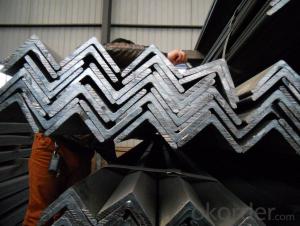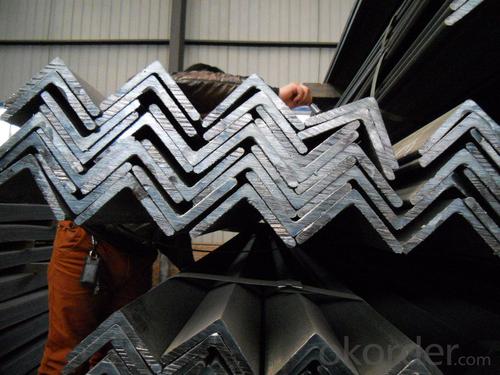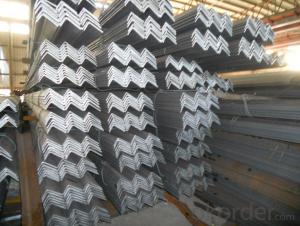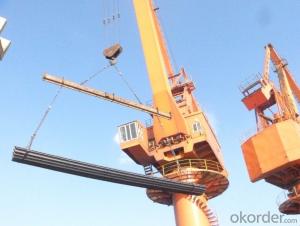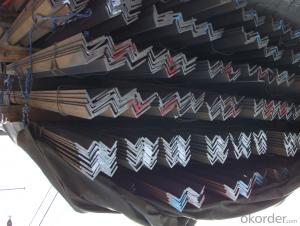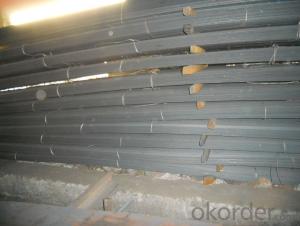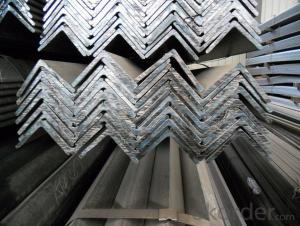Hot Rolled Equal Angle Steel Bar Different Sizes High Quality
- Loading Port:
- China Main Port
- Payment Terms:
- TT or LC
- Min Order Qty:
- -
- Supply Capability:
- -
OKorder Service Pledge
OKorder Financial Service
You Might Also Like
Product Description:
OKorder is offering Angle Bar at great prices with worldwide shipping. Our supplier is a world-class manufacturer of steel, with our products utilized the world over. OKorder annually supplies products to European, North American and Asian markets. We provide quotations within 24 hours of receiving an inquiry and guarantee competitive prices.
Product Applications:
According to the needs of different structures, Angle can compose to different force support component, and also can be the connections between components. It is widely used in various building structures and engineering structures such as roof beams, bridges, transmission towers, hoisting machinery and transport machinery, ships, industrial furnaces, reaction tower, container frame and warehouse etc.
.
Product Advantages:
OKorder's Angle Bar are durable, strong, and resist corrosion.
Main Product Features:
· Premium quality
· Prompt delivery & seaworthy packing (30 days after receiving deposit)
· Corrosion resistance
· Can be recycled and reused
· Mill test certification
· Professional Service
· Competitive pricing
Product Specifications:
Name | Stainless Steel Angles | ||||||
Standard | ASTM A554, A312, A249, A269 and A270 | ||||||
Material Grade | 304,316,201,202, 316L,430 | ||||||
Length | 6m or as customers' request | ||||||
Tolerance | a) thickness: +/-0. 15mm | ||||||
b) Length:+/-4. 5mm - 0mm | |||||||
Surface | 180G, 320G, 400G Satin / Hairline(Matt Finish, Brush, Dull Finish) 400G, 500G, 600G or 800G Mirror finish | ||||||
Application | Decoration construction, upholstery, industry instruments | ||||||
Test | Squash test, Extended test, Water pressure test, Crystal rot test, Heat treatment, NDT | ||||||
Chemical Composition of Material | Composition Material | 201 | 202 | 304 | 316L | 430 | |
C | ≤0.15 | ≤0.15 | ≤0.08 | ≤0.08 | ≤0.12 | ||
Si | ≤1.00 | ≤1.00 | ≤1.00 | ≤1.00 | ≤1.00 | ||
Mn | 5.5-7.5 | 7.5-10 | ≤2.00 | ≤2.00 | ≤1.00 | ||
P | ≤0.06 | ≤0.06 | ≤0.045 | ≤0.045 | ≤0.040 | ||
S | ≤0.03 | ≤0.03 | ≤0.030 | ≤0.030 | ≤0.030 | ||
Cr | 16-18 | 17-19 | 18-20 | 16-18 | 16-18 | ||
Ni | 3.5-5.5 | 4-6 | 8-10.5 | 10-14 | |||
Mo | 2.0-3.0 | ||||||
Mechanical Property | Material Item | 201 | 202 | 304 | 316L | ||
Tensile Strength | ≥535 | ≥520 | ≥520 | ≥520 | |||
Yield Strength | ≥245 | ≥205 | ≥205 | ≥205 | |||
Extension | ≥30% | ≥30% | ≥35% | ≥35% | |||
Hardness (HV) | <253 | <253 | <200 | <200 | |||
FAQ:
Q1: Why buy Materials & Equipment from OKorder.com?
A1: All products offered byOKorder.com are carefully selected from China's most reliable manufacturing enterprises. Through its ISO certifications, OKorder.com adheres to the highest standards and a commitment to supply chain safety and customer satisfaction.
Q2: How do we guarantee the quality of our products?
A2: We have established an advanced quality management system which conducts strict quality tests at every step, from raw materials to the final product. At the same time, we provide extensive follow-up service assurances as required.
Q3: How soon can we receive the product after purchase?
A3: Within three days of placing an order, we will begin production. The specific shipping date is dependent upon international and government factors, but is typically 7 to 10 workdays.
Q4: What makes stainless steel stainless?
A4: Stainless steel must contain at least 10.5 % chromium. It is this element that reacts with the oxygen in the air to form a complex chrome-oxide surface layer that is invisible but strong enough to prevent further oxygen from "staining" (rusting) the surface. Higher levels of chromium and the addition of other alloying elements such as nickel and molybdenum enhance this surface layer and improve the corrosion resistance of the stainless material.
Q5: Can stainless steel rust?
A5: Stainless does not "rust" as you think of regular steel rusting with a red oxide on the surface that flakes off. If you see red rust it is probably due to some iron particles that have contaminated the surface of the stainless steel and it is these iron particles that are rusting. Look at the source of the rusting and see if you can remove it from the surface.
Images:
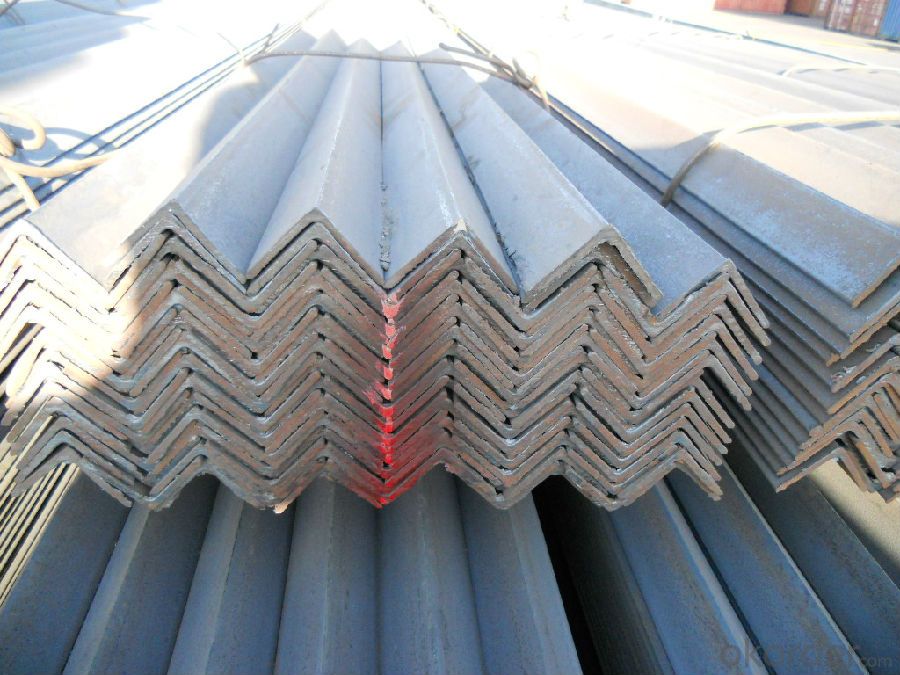
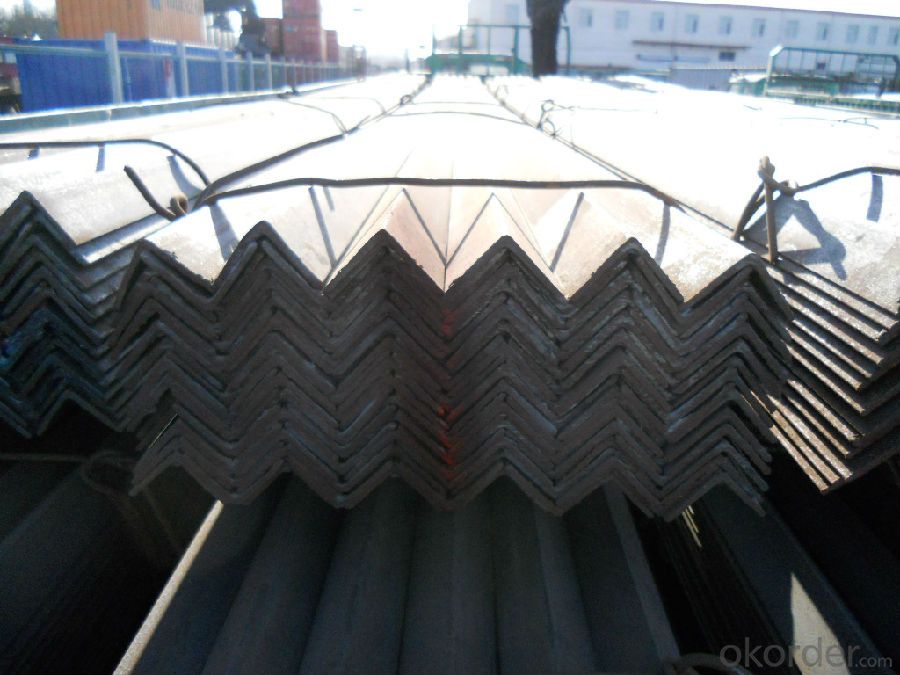
- Q: Unequal angle steel
- Unequal angle steel: in the field of engineering materials, relative to two equal side length equal angles, refers to the section of the right angle, L shaped, and unequal length of both sides of the angle. It is widely used in engineering structure, structure and variety of municipal public utilities, civil and military industries, such as industrial beams, bridges, towers, hoisting and conveying machinery, ships, industrial furnace, reaction tower, container frame, and warehouses, because the amount is less than the unilateral angle, so the relative price slightly higher.
- Q: Can steel angles be used in seismic or high-wind areas?
- Yes, steel angles can be used in seismic or high-wind areas. Steel angles are commonly used in construction for their strength and durability. They are able to withstand the forces exerted during seismic events or strong winds, making them a suitable choice for such areas. Additionally, steel angles can be designed and reinforced to meet specific requirements for these challenging conditions.
- Q: Are steel angles suitable for mezzanine floor construction?
- Indeed, steel angles prove to be suitable for the construction of mezzanine floors. Mezzanine floor construction commonly incorporates steel angles due to their robustness and long-lasting nature. They offer exceptional support and stability, thereby making them an ideal choice for bearing the weight of the mezzanine floor and any additional loads placed upon it. By simply bolting or welding steel angles together, a sturdy framework can be easily created for the mezzanine floor. Moreover, steel angles can be tailored to meet specific design requirements, thereby allowing for flexibility in mezzanine floor construction. In summary, steel angles provide a dependable and cost-effective solution for the construction of mezzanine floors.
- Q: Can steel angles be used in curtain wall construction?
- Yes, steel angles can be used in curtain wall construction. Steel angles are commonly used as structural supports and framing elements in curtain wall systems. They provide stability, strength, and durability to the overall structure, allowing for the installation of glass panels or other cladding materials.
- Q: Can steel angles be used for mezzanine floors?
- Indeed, mezzanine floors can be constructed using steel angles. In construction, steel angles are widely employed as structural elements, particularly for mezzanine floors. They offer stability and support to the framework, enabling the expansion of floor space. With their robustness and durability, steel angles are ideal for bearing substantial loads and guaranteeing the security of the mezzanine floor. Furthermore, the fabrication and installation of steel angles are effortless, rendering them a cost-efficient option for the construction of mezzanine floors.
- Q: Do steel angles have a smooth or textured surface?
- Steel angles typically have a textured surface. The texture is created during the manufacturing process when the steel is hot-rolled or cold-formed to create the angle shape. This process results in a slightly rough or bumpy surface on the steel angles, which helps to provide better grip and stability when they are used in various applications. Additionally, this texture can also help to prevent slipping or sliding of objects that come into contact with the steel angles. However, it is important to note that the level of texture may vary depending on the specific manufacturing process and the intended use of the steel angles.
- Q: How do steel angles perform in terms of impact resistance?
- Steel angles have a strong performance when it comes to resisting impacts. Their structural design allows them to withstand high impact forces and distribute them evenly along their length. This quality makes them suitable for various applications, including construction, industrial machinery, and automotive frames, where impacts or dynamic loads are expected. The excellent impact resistance of steel stems from its high strength and toughness. Steel angles are typically made from low carbon steel or alloy steel, both known for their high tensile strength and ability to absorb energy without breaking. As a result, steel angles can resist deformation and maintain their structural integrity even under heavy impacts. Furthermore, the impact resistance of steel angles can be further enhanced by using specific steel grades or applying surface treatments like galvanization or powder coating. These treatments not only improve the corrosion resistance of steel angles but also enhance their overall durability, making them even more resistant to impacts and harsh environmental conditions. However, it is essential to note that the impact resistance of steel angles can vary depending on factors like dimensions, thickness, and material properties. Therefore, it is recommended to consult with a structural engineer or refer to technical specifications provided by manufacturers to ensure that the chosen steel angle is suitable for the intended application and expected impact loads.
- Q: What are the different methods of surface preparation for painting steel angles?
- Some different methods of surface preparation for painting steel angles include abrasive blasting, chemical cleaning, and power tool cleaning. Abrasive blasting involves using high-pressure air or water to propel abrasive materials onto the surface of the steel angle, removing any rust, scale, or other contaminants. Chemical cleaning involves applying specific chemicals to the steel angle to dissolve or remove any contaminants. Power tool cleaning involves using power tools such as grinders or sanders to mechanically remove any rust, scale, or other contaminants from the surface of the steel angle.
- Q: Can steel angles be used in window frames?
- Indeed, window frames can incorporate steel angles. These steel angles find frequent application in construction, offering both structural reinforcement and stability to window frames. They often serve as reinforcements or brackets, connecting the window frame to the wall or other elements of the window system. Steel angles possess remarkable durability, strength, and resistance to corrosion, rendering them an excellent option for window frame construction. Moreover, steel angles can be effortlessly tailored and fabricated to suit various window sizes and designs.
- Q: What are the different surface finishes available for galvanized steel angles?
- There are several different surface finishes available for galvanized steel angles. 1. Smooth: This is the most common surface finish for galvanized steel angles. It provides a smooth and polished appearance, making it suitable for a wide range of applications. 2. Matte: Matte finish is achieved by applying a chemical treatment to the galvanized steel angles. This finish provides a non-reflective surface, making it ideal for applications where glare is a concern. 3. Textured: Textured finish involves adding a textured pattern to the surface of the galvanized steel angles. This can be done through embossing or by applying a textured coating. The textured surface enhances grip and provides a decorative element. 4. Powder coated: Galvanized steel angles can also be powder coated, which involves applying a dry powder to the surface and then curing it in a high-temperature oven. Powder coating offers a durable and attractive finish, with a wide range of color options available. 5. Painted: Another option is to paint the galvanized steel angles. This can be done using either oil-based or water-based paints. Painting adds an extra layer of protection against corrosion and can be customized to match specific color requirements. Overall, the choice of surface finish for galvanized steel angles depends on the intended use, aesthetic preferences, and the level of protection required against corrosion. It is important to consider the environmental conditions and the specific needs of the application when selecting a surface finish.
Send your message to us
Hot Rolled Equal Angle Steel Bar Different Sizes High Quality
- Loading Port:
- China Main Port
- Payment Terms:
- TT or LC
- Min Order Qty:
- -
- Supply Capability:
- -
OKorder Service Pledge
OKorder Financial Service
Similar products
Hot products
Hot Searches
Related keywords
